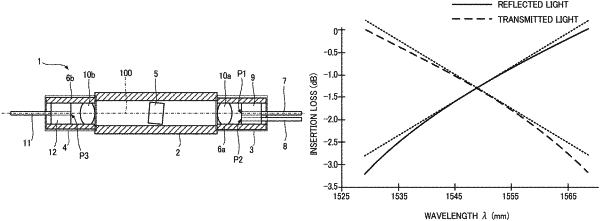| CPC G02B 6/29361 (2013.01) [G02B 6/32 (2013.01); H04B 10/294 (2013.01); H04B 10/2941 (2013.01); G02B 6/293 (2013.01); G02B 6/29362 (2013.01)] | 4 Claims |

|
1. A slope gain equalizer that corrects an inclined gain characteristic in an optical signal in a predetermined wavelength bandwidth, comprising:
a dual-core fiber collimator that holds a first optical fiber and a second optical fiber;
a single-core fiber collimator that holds a third optical fiber; and
an interference filter, wherein
the dual-core fiber collimator and the single-core fiber collimator are arranged to face each other on an optical axis,
the interference filter is arranged between the dual-core fiber collimator and the single-core fiber collimator on the optical axis,
when an optical signal of a predetermined bandwidth is inputted from the first optical fiber or the second optical fiber, the optical signal is reflected by the interference filter and is outputted from the second optical fiber or the first optical fiber,
when the optical signal is inputted from the first optical fiber or the third optical fiber, the optical signal is transmitted through the interference filter and is outputted from the third optical fiber or the first optical fiber,
a wavelength dependence of insertion loss in a reflecting direction in the predetermined wavelength bandwidth of the interference filter is sloped so as to increase or decrease gradually from a short wavelength side to a long wavelength side,
a wavelength dependence of insertion loss in a transmitting direction in the predetermined wavelength bandwidth of the interference filter is sloped so as to decrease or increase gradually from a short wavelength side to a long wavelength side so as to slope in the opposite direction from the slope in the insertion loss of the reflecting direction, and
the first to the third optical fibers are coupled to an input-output route of the optical signal such that a slope of a wavelength dependence of a gain characteristic in the optical signal and a slope of a wavelength dependence of the insertion loss in the interference filter are in opposite directions.
|